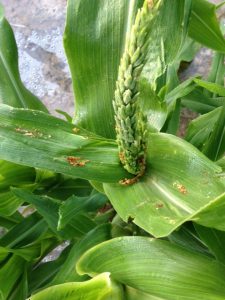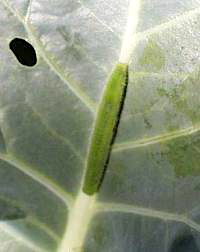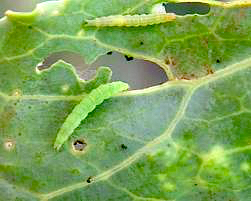Sweet Corn
 European corn borer (ECB) moths continue to be captured in black light traps, but numbers are low overall. Activity has shifted northward, with the highest activity now from Mercer County northward (see ECB map). Despite these low adult numbers, IPM technicians have reported dramatic increases in feeding in whorl stage plantings in the central and northern counties. Numbers of infested plants have reached 40% in the Somerville area, and 30% near Sparta in Sussex County. In many cases, nearby farms exhibit little or no feeding in similar stage sweet corn, so these elevated infestation rates can be highly localized. Generally, as ECB moth activity declines, feeding injury rises with the hatching of eggs that were deposited by adults. As early sweet corn plantings progress through whorl and pre-tassel stages, feeding from this pest will increase. Look for the characteristic “shot-hole” type of feeding (photo below at right) and consider treating when
European corn borer (ECB) moths continue to be captured in black light traps, but numbers are low overall. Activity has shifted northward, with the highest activity now from Mercer County northward (see ECB map). Despite these low adult numbers, IPM technicians have reported dramatic increases in feeding in whorl stage plantings in the central and northern counties. Numbers of infested plants have reached 40% in the Somerville area, and 30% near Sparta in Sussex County. In many cases, nearby farms exhibit little or no feeding in similar stage sweet corn, so these elevated infestation rates can be highly localized. Generally, as ECB moth activity declines, feeding injury rises with the hatching of eggs that were deposited by adults. As early sweet corn plantings progress through whorl and pre-tassel stages, feeding from this pest will increase. Look for the characteristic “shot-hole” type of feeding (photo below at right) and consider treating when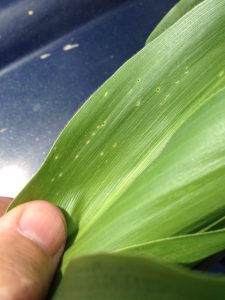 infested plants exceed 12% in a 50 plant sample. As infested plants proceed to the pre-tassel stage, live larvae and damage may be found in the emerging tassels (see bottom photo at left). Once plants hit full tassel, ECB larvae will move downward on the stalk and re-enter the plant near the area where ears are forming. This can result in direct injury to the ear. Growers should consider an insecticide application at the full tassel stage to target ECB larvae as they migrate downward. This application can eliminate larvae that have escaped any earlier insecticide applications.
infested plants exceed 12% in a 50 plant sample. As infested plants proceed to the pre-tassel stage, live larvae and damage may be found in the emerging tassels (see bottom photo at left). Once plants hit full tassel, ECB larvae will move downward on the stalk and re-enter the plant near the area where ears are forming. This can result in direct injury to the ear. Growers should consider an insecticide application at the full tassel stage to target ECB larvae as they migrate downward. This application can eliminate larvae that have escaped any earlier insecticide applications.
The highest nightly trap catches of ECB for the week ending 6/06/18 are as follows:
| Sergeantsville 2 | East Vineland 1 | Lawrenveville 1 |
| Centerton 1 | Eldora 1 | Medford 1 |
| Crosswicks 1 | Farmingdale 1 | Newton 1 |
| Denville 1 | Hackettstown 1 | Pennington 1 |
A few corn earworm (CEW) moths are still appearing in blacklight traps. These numbers are quite low, but with some early plantings in southern NJ now at or near silk stage, this pest poses a threat. In addition, though the deployment of the CEW pheromone trap network in the southern counties is not yet complete, one operating trap near Woodstown registered 18 moths per night this week. In this area, the risk to any silking sweet corn is significant. We typically get a few CEW moths early in June when southerly breezes move them here. This sporadic activity generally subsides in the second half of the month through mid-July.
The highest nightly black light trap catches of CEW for the week ending 6/06/18 are as follows:
| Folsom 1 | Hackettstown 1 |
Silking Spray Schedules*:
South – 4-5 days
Central – 6 days
*These recommendations are based on regional catches. Adhere to tighter spray schedules if indicated by local trap catches.
Cole Crops
Increasing levels of imported cabbageworm (ICW- photo at upper left) and diamondback moth larvae (DBM – photo at lower left) have been found in cole crop plantings in central and northern NJ this week. These infestations will increase rapidly as the spring season progresses. Check 5 consecutive plants each in 10 random locations throughout the planting, paying particular attention to the innermost leaves where ICW often feed. Consider treating if caterpillars are found on 10% or more plants that are in the 0-9 true leaf stage. From 9-leaf to the early head stage (in broccoli, cauliflower, and cabbage) infestations up to 20% may be tolerated. Once heads begin to form, a 5% threshold should be observed to protect the marketable portion of the plant. For leafy greens such as collards and kale, 10% plants infested is the threshold throughout.
Some populations of DBM are resistant to carbamate and synthetic pyrethroid insecticides. The lack of DBM control with these insecticides has been noted in NJ previously. It is important to distinguish between common cole crop pests for this reason. DBM larvae grow to a length of approximately 0.5”, and taper toward both ends. These caterpillars thrash violently when disturbed. ICW grow to a length of approximately 1.25” and are covered with short hairs. Newer chemistries that specifically target caterpillar pests are effective against DBM as well as all other caterpillar pests of cole crops. These materials include (active ingredient – trade name (IRAC* code)):
Spinosad/Spinetoram – Entrust/ Radiant (5)
Chlorantraniliprole – Coragen (28)
Cyantraniliprole – Exirel (28)
The IRAC group 5 insecticide, Entrust, is OMRI approved for organic production. Insecticides based on the soil-inhabiting bacterium Bacilllus thuringiensis (B.t.) may also be effective on caterpillar pests of cole crops. Examples include Xentari and Javelin.
Flea beetles remain very active in many plantings, particularly during the warmer days. These pests have a preference for the “hotter” flavored crops like arugula, mustard greens, and turnip greens. They also attack Tuscan or lacinato kale frequently. Plants may be protected with at-planting, soil-applied neo-nicotinoid insecticides (see the 2018 Commercial Vegetable Production Recommendations for products). An OMRI approved foliar material for flea beetle management is Pyganic. This product will provide knock-down of flea beetles, but may need to be applied frequently on preferred host crops.
Peppers
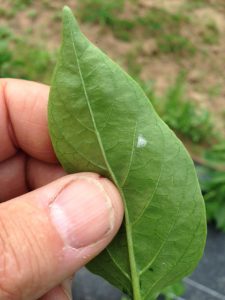 With continuing ECB moth activity, growers should be looking for ECB egg masses (see photo at left) on the underside of pepper leaves. The larvae that hatch from these eggs will bore into the central stem of pepper plants in the absence of suitable fruit. This damage causes the tops of the plant to die, and eliminating the crown set of fruit in the process. Check 2 leaves per plant on 5 consecutive plants in 10 random locations. Consider treating if 2 or more leaves are found to have ECB larvae on the lower surface.
With continuing ECB moth activity, growers should be looking for ECB egg masses (see photo at left) on the underside of pepper leaves. The larvae that hatch from these eggs will bore into the central stem of pepper plants in the absence of suitable fruit. This damage causes the tops of the plant to die, and eliminating the crown set of fruit in the process. Check 2 leaves per plant on 5 consecutive plants in 10 random locations. Consider treating if 2 or more leaves are found to have ECB larvae on the lower surface.
Pepper Weevil
No weevils were trapped in the past week. As far as known there are no known infested fields at this time.
Tomatoes
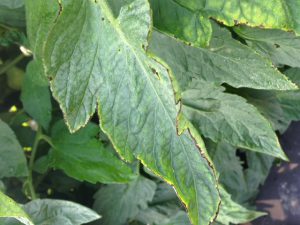 Field scouting of outdoor and high tunnel tomatoes continues. Bacterial leaf spot infections (see photo at left) have begun to appear in some fields following heavy rains. Look for very dark lesions on leaf margins, and on the interior of immature leaves. Lesions will have chlorotic borders and may cause immature leaves not to expand properly. Growers should treat preventively for this disease prior to symptoms. See the tomato section of the 2018 Commercial Vegetable Recommendations Guide for materials and spray schedules.
Field scouting of outdoor and high tunnel tomatoes continues. Bacterial leaf spot infections (see photo at left) have begun to appear in some fields following heavy rains. Look for very dark lesions on leaf margins, and on the interior of immature leaves. Lesions will have chlorotic borders and may cause immature leaves not to expand properly. Growers should treat preventively for this disease prior to symptoms. See the tomato section of the 2018 Commercial Vegetable Recommendations Guide for materials and spray schedules.
Two-spotted spider mites (TSSM) infestations are now appearing in some high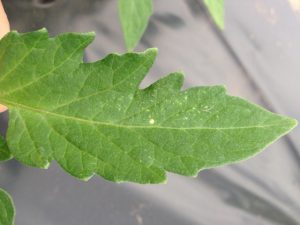 tunnel tomato crops. This pest is favored by the warm, dry conditions found in the tunnels. When scouting, be sure to check leaves from the lower level of the canopy as well as other areas, as TSSM often begins feeding on the lowest leaves. Look for the characteristic mite “stipple” (white pin spots on the upper leaf surface – see photo at right). Mites should be visible on the lower leaf surface. Early treatment is essential to achieve acceptable control of this pest.
tunnel tomato crops. This pest is favored by the warm, dry conditions found in the tunnels. When scouting, be sure to check leaves from the lower level of the canopy as well as other areas, as TSSM often begins feeding on the lowest leaves. Look for the characteristic mite “stipple” (white pin spots on the upper leaf surface – see photo at right). Mites should be visible on the lower leaf surface. Early treatment is essential to achieve acceptable control of this pest.
Brown marmorated stink bug (BMSB)
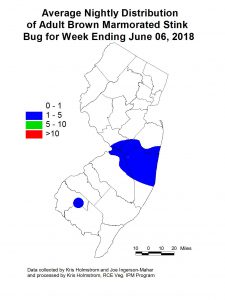 There was an increase in BMSB catches in central Jersey black light traps this past week (see BMSB map at left). Although this pest has not had serious impact on vegetable crops like peppers in recent years, it is still a significant pest of tree fruits. The numbers are not high, but represent a shift in activity over last week.
There was an increase in BMSB catches in central Jersey black light traps this past week (see BMSB map at left). Although this pest has not had serious impact on vegetable crops like peppers in recent years, it is still a significant pest of tree fruits. The numbers are not high, but represent a shift in activity over last week.
The highest nightly trap catches of BMSB for the week ending 6/06/18 are as follows:
| New Egypt 5 | Crosswicks 2 | Matawan 1 |
| Allentown 3 | Farmingdale 2 | Pedricktown 1 |
| Centerton 3 | Old Bridge 2 | Princeton 1 |
| Georgetown 3 | Dayton 1 | Tabernacle 1 |
2018 Vegetable IPM Program Personnel
Kris Holmstrom and Joe Ingerson-Mahar would like to acknowledge the IPM Field Technicians for this season:
Justine Cieslik
James Duffy
Dylan McCollough
Nancy Michaelsen
Ryan Tirrell
Luann Winters
Without the assistance of these individuals, much of the information presented in this publication would be unobtainable. We are grateful for all their help and hard work.
